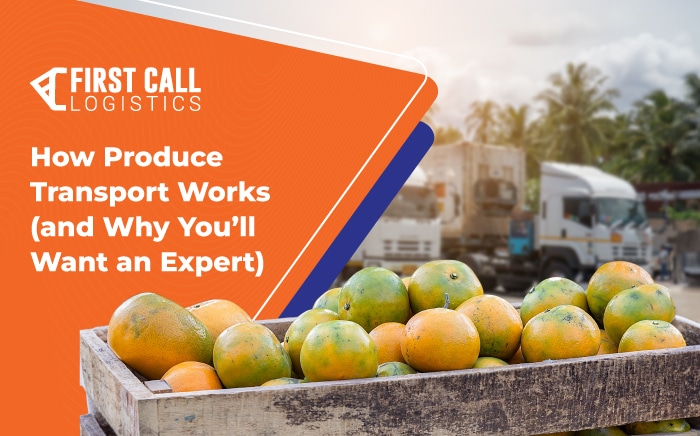How Produce Transport Works (and Why You’ll Want an Expert)

The food and beverage industry is vast, and requires increasingly sustainable solutions for the challenges it faces now and in the future. Feeding an estimated 10 billion people by 2050 means some major changes are likely in store, from drastically reducing food waste to improving overall soil and water management. Much of the responsibility to reduce waste (and its associated costs) falls to transportation services, as an estimated 16% of all food products in the U.S. are lost each year somewhere between post-harvest and retail due in large part to transportation failures.
As the general public begins to settle back into a sense of normalcy with schools, restaurants, outdoor activities, and live sporting events back on the menu, the foodservice industry is expected to respond in kind. Food transport is thus expected to return to full pre-pandemic workloads and to the same challenges every business is tasked with when it comes to safely shipping perishable goods.
Common Challenges in Food Transport
Transporting goods from the field to a retail store takes planning. Considering issues like temperature control both in storage and in transit, efficient delivery for produce with limited shelf life, keeping vehicles clean and sanitized, and meeting all required legal regulations while you form your action plan will save you headaches in the long run. Transportation of goods is a process, and only a well-oiled process will get produce to where it’s going in time (and in pristine condition) to be enjoyed.
While many of food transport’s challenges are technical and logistical in nature, there are other matters to consider—driver shortages and environmental issues are also frequent obstacles forcing transport providers to seek more innovative and cost-effective solutions.
Produce Transportation Best Practices
Shipping fresh produce effectively comes down to how strictly you can control the temperature of the goods through each step of the transportation process. Specific requirements must be met depending on the type of item being shipped and can be accomplished by manipulating the following key factors.
How are the goods packaged? Keeping produce insulated against temperature changes can mitigate lengthier shipping times to an extent and protect goods from spoiling when used in conjunction with coolants.
Can the goods be safely frozen? Coolants, most frequently in the form of frozen gel packs, keep produce cold in transit when paired with the right packing material (usually a polyurethane foam). Dry ice is also a form of coolant for goods that need to remain entirely frozen, but can harm more delicate food items and requires a carrier qualified to handle hazardous materials.
What about climate control systems? Some vehicles have the ability to keep products within specific temperature ranges, which is much harder to accomplish through packaging and coolants alone. Quality climate control systems take up space within the vehicle, but make it possible to safely transport root vegetables to soft fruits to leafy greens at optimal temperatures to ensure freshness upon delivery.
Acceptable temperature ranges by food item:
- Root vegetables: 39.2° to 53.6°F
- Squash: 41° to 50°F.
- Soft fruits and leafy greens: Near-freezing temperatures (just above 32°F)
- Citrus: 39° to 77°F
What about storage compatibility? Knowing the specific requirements for every commodity you store and ship is crucial. Understanding how to pair and transport different types of produce in the same shipment can save you money and time, so long as those produce types are compatible for the period of time they’re paired together in storage and shipping containers.
Properly managing the cold chain, including tight control over humidity and ethylene levels in both warehouses and trucks, extends the shelf life of your produce shipments. Most green vegetables are especially sensitive to ethylene gas and should be stored separately from ethylene-producing fruits. Produce stored in close proximity also risks mixing odors and flavors to the detriment of the product — odiferous produce must be handled with care and kept separate from products that tend to absorb its aroma.
Achieving this level of care when transporting produce takes extensive checks and testing, as well as strict adherence to detailed safety procedures on the part of the shipper, carrier, receiver, and transportation provider.
What Shippers Can Expect from Produce Season 2024
Produce season ranges from the initial spring harvest to the end of summer. The rush to ship fresh in-season produce from the country’s warmer climates to all other major markets is large enough to drive up freight shipping rates each year.
Any business requiring transportation of goods is likely to experience some ripple effect during peak produce season, particularly in areas that experience a sudden rush of drivers and servicers looking to capitalize on the busy season. Florida, Texas, and California are among the most dramatically impacted regions each year.
Working with 3PLs That Understand the Produce Industry
Using an experienced logistics provider gives your business a leg up on its competition. Partnering with an experienced 3PL helps you navigate unexpected circumstances and adapt to changing conditions (like a post-pandemic surge of demand) through years of technical expertise.
A good 3PL will help you eliminate wasteful spending, easily handle specific temperature control requirements, manage produce season like a pro, and deliver your goods fresh and ready to eat in the most efficient manner possible. Remember to seek out a 3PL with the capacity, reliability, and experience to support your growing business.
Ace Produce Season with First Call Logistics
Interested in acing produce season? First Call Logistics has proudly specialized in produce distribution since 2005. Reach out to First Call Logistics for a quote today!